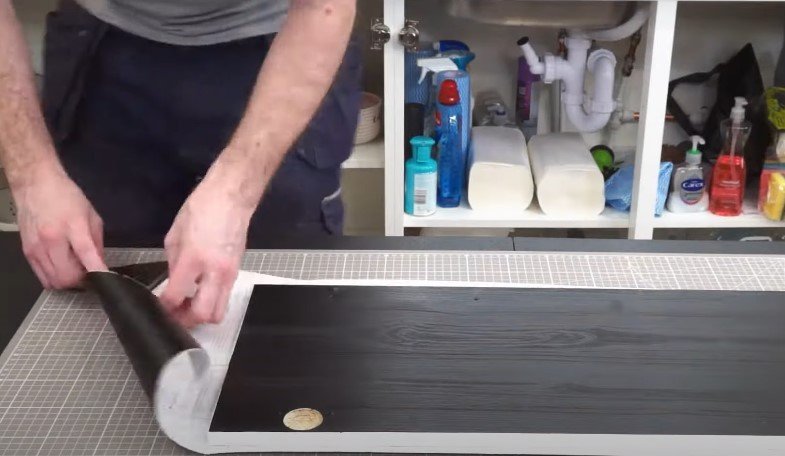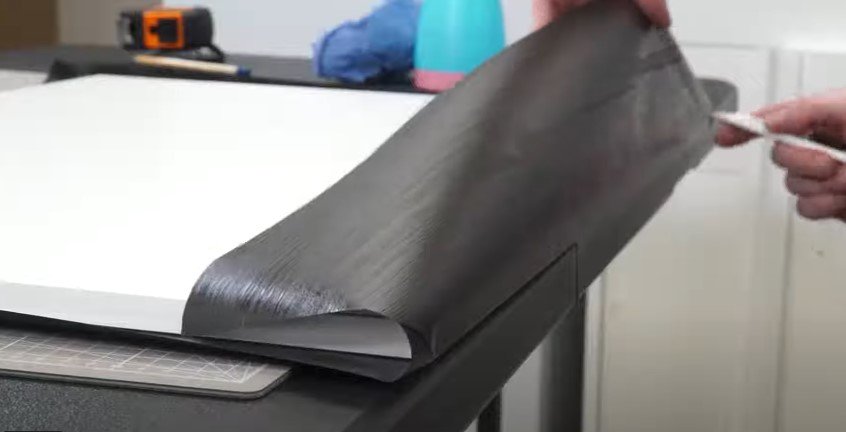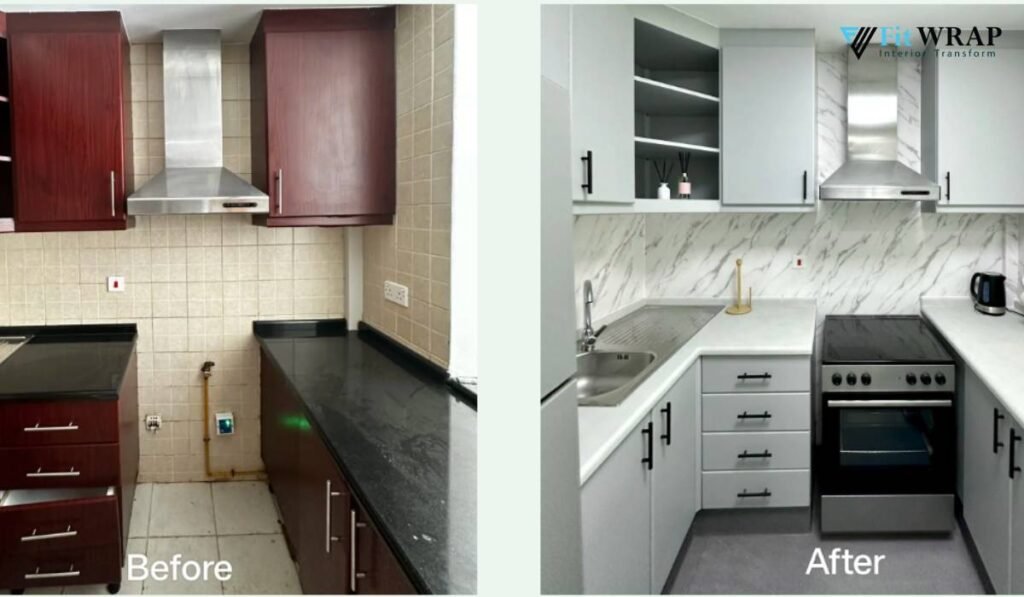Thinking of giving your kitchen a fresh look? You might be asking yourself: Is it better to paint or vinyl wrap kitchen cupboards? I’ve stood in that same spot—paint in one hand, vinyl wrap in the other—not sure what to pick. Both options seem easy at first, but they have real pros and cons. In this guide, I’ll share what I’ve learned from doing both. We’ll talk cost, style, and even how to remove vinyl wrap if you change your mind later. Let’s find what works best for your home.
Paint or Vinyl Wrap Kitchen Cupboards: What’s the Difference?
When deciding whether to paint or vinyl wrap kitchen cupboards, it’s essential to understand what each option actually involves. Both have their ups and downs, but knowing the basics will help you choose the best fit for your kitchen.
What Does It Mean to Paint Kitchen Cupboards?
Painting kitchen cupboards is pretty straightforward. You start by selecting the right paint for the job—latex, oil-based, or even chalk paint. Each has its advantages, with latex being the most common for kitchen use because it’s durable and easy to clean. Oil-based paints, on the other hand, provide a smooth, glossy finish but take longer to dry and can be a bit tricky to work with.
You’ll also need to spend some time prepping the surface. That means cleaning, sanding, and priming your cupboards to make sure the paint sticks properly. It’s a bit of a process, and it might take a few days to finish, especially if you have a large kitchen.
What Is Vinyl Wrapping for Kitchen Cupboards?
Now, vinyl wrapping—particularly DC Fix or self-adhesive vinyl—has gained quite a bit of popularity. This is a sticker-like material that you peel and stick onto your kitchen cupboards. The best part? It’s quick and easy. The vinyl comes in various designs and textures, from wood finishes to glossy colors, allowing you to easily match your desired style.
The process is simple and doesn’t require sanding or priming. Just measure and cut the vinyl to fit your cupboard doors, then apply it. It’s an ideal choice for a quick kitchen makeover, especially if you don’t have much time.
| Option | Pros | Cons |
| Painting Kitchen Cupboards | – Customizable colors and finishes.- Durable when applied correctly.- Polished, professional look.- Great for modern or classic styles. | – Can chip or peel over time, especially with high use.- Time-consuming and requires multiple steps.- Messy process, needing careful preparation. |
| Vinyl Wrapping Kitchen Cupboards | – Quick and easy to apply.- Available in a variety of textures and finishes (e.g., wood, gloss).- Affordable compared to painting. | – Can peel over time, especially with heat or humidity.- Less durable than paint, especially in high-traffic areas.- Limited long-term lifespan. |

Factors to Consider When Choosing Between Paint and Vinyl Wrap
When deciding whether to paint or vinyl wrap your kitchen cupboards, several key factors come into play. Let’s break them down so you can make an informed choice based on your needs, lifestyle, and preferences.
Durability & Longevity
Both options offer durability, but how long will they truly last? Paint tends to be more durable, especially if you opt for high-quality paint and proper preparation. With the right maintenance, painted cupboards can last for years without major issues. However, paint can chip, especially in high-traffic areas.
On the other hand, vinyl wrap is a great option for quick makeovers, but it generally has a shorter lifespan. While it’s resistant to staining and easy to clean, vinyl can start peeling over time, especially with exposure to heat and moisture in the kitchen. If you’re someone who likes to keep things fresh, you may need to replace the vinyl wrap sooner than you would repaint.
Cost Comparison
Cost is always a big factor when updating your kitchen. In most cases, vinyl wrapping is the cheaper option, especially if you’re planning to DIY. Vinyl rolls are relatively inexpensive, and the installation process is straightforward enough for most people to manage without professional help. However, if you choose to hire a professional, the price can go up significantly.
Painting, on the other hand, can be more expensive, particularly if you’re hiring a professional. The cost of good-quality paint, primers, and brushes can add up quickly. And if you decide to tackle it yourself, there’s the time investment to consider, as the process can be quite labor-intensive. But, in the long run, painting may provide a more cost-effective solution if you maintain the cupboards well.
Aesthetic & Design Flexibility
One area where paint truly shines is its flexibility. You can choose from nearly any color under the sun and mix it with various finishes like matte, gloss, or satin. This means you can create a custom look tailored to your kitchen’s vibe. Whether you’re going for a modern, rustic, or sleek design, paint can fit any style.
Vinyl wrap, however, offers a more limited selection of textures and patterns. While there are plenty of designs, including options that mimic wood or high-gloss finishes, it’s not as versatile as paint. But if you’re looking for a quick and trendy update, vinyl wrap might give you the fresh look you’re after without the commitment of a painted finish.
Time & Effort Involved
Let’s talk about how much time you’re willing to invest. If you need to get your kitchen back in action quickly, vinyl wrapping is the clear winner. The process is relatively fast, with minimal prep required. You can complete the entire project in a day or two if you’re working with a smaller kitchen.
Painting, however, takes longer. You’ll need to spend time prepping the surfaces, applying multiple coats, and allowing everything to dry between steps. Plus, you’ll need to factor in the downtime while your kitchen is out of commission. If you’re on a tight timeline, vinyl wrap is the faster solution.
.
Maintenance and Cleaning
Once you’ve made your choice—paint or vinyl wrap—keeping your kitchen cupboards clean is key to making them last. Let’s look at what everyday care looks like for each option and what you can expect over time.
Painted Kitchen Cupboards
Painted cupboards are pretty easy to maintain. Just wipe them down with a soft cloth and mild soap. Avoid harsh chemicals, as they can damage the finish. If you go with high-quality paint and sealant, the surface will hold up well against grease and splashes.
But over time, paint may chip especially around handles or edges. If that happens, you can touch up small spots with leftover paint. It’s a quick fix and keeps your kitchen looking fresh without a full redo.
Vinyl-Wrapped Kitchen Cupboards
Vinyl wrap is smooth and non-porous, so it’s great for busy kitchens. Just wipe with a damp cloth—no need for strong cleaners. Most people love how easy it is to maintain.
However, one thing to watch for is peeling. Edges and corners are most at risk, especially near heat sources like ovens or kettles. Once peeling starts, it’s hard to stop without replacing the vinyl. Still, with gentle care and a bit of caution, wraps can last for years.
Long-Term Wear and Tear
Here’s the simple truth: paint may chip, and vinyl may peel. But both can look great for a long time if you treat them well. Choose the one that fits your routine. If you want something low-effort, vinyl might be for you. If you’re okay with the occasional touch-up, paint is a solid choice.
Quick Comparison Table: Cleaning & Maintenance
| Feature | Painted Cupboards | Vinyl-Wrapped Cupboards |
| Daily Cleaning | Mild soap and cloth | Damp cloth only |
| Resistance to Grease | High with sealant | High |
| Risk of Damage Over Time | Chipping near edges | Peeling near heat or water |
| Touch-Up or Repair Options | Easy to repaint small areas | Hard to patch; may need full re-wrap |
| Long-Term Care | Occasional touch-ups | Careful cleaning to avoid peeling |

How to Remove Vinyl Wrap (If You Change Your Mind)
So, you’ve wrapped your kitchen cupboards, but now you’re ready for a change. Maybe the color no longer fits your style, or perhaps the vinyl has started peeling. Don’t worry—removing vinyl wrap from kitchen doors is easier than you might think.
Step-by-Step: How to Remove Vinyl Wrap from Kitchen Doors
- Start with Heat
Use a hair dryer or heat gun on low heat. Gently warm the vinyl surface to loosen the adhesive. Move the heat source in small circles, keeping it a few inches away from the cupboard. - Peel Slowly
Once warm, lift a corner of the vinyl with your fingernail or a plastic scraper. Go slow—pulling too fast can tear the wrap or leave sticky bits behind. Angle the peel at 45 degrees for best results. - Clean Off Residue
If any glue remains, use a mix of warm water and dish soap or a gentle adhesive remover like Goo Gone. Wipe the surface with a soft cloth until clean. Avoid harsh scrubbing to protect the cupboard finish underneath. - Inspect the Surface
Check for any damage. If the original paint or laminate looks scratched, you may want to sand and repaint or prep it for a fresh vinyl wrap.
Tips for a Smooth Removal
- Work in small sections. It gives you better control.
- Avoid metal tools. They can scratch your doors.
- Don’t rush. Patience prevents damage and mess.
Final Thoughts
So, is it better to paint or vinyl wrap kitchen cupboards? The truth is—it depends on you. Your budget, your style, and how much time you’re willing to invest all play a role. There’s no one-size-fits-all answer.
Think about how you use your kitchen every day. Do you want a fast makeover or a more permanent change? Are you up for a DIY project or hiring a pro? Whatever you choose, both options can totally refresh your space without the cost of a full renovation.
If you’re still unsure whether to paint or vinyl wrap kitchen cupboards, start small. Try wrapping just a few doors or painting a test cabinet. That way, you’ll get a feel for the process and see what fits your home best.
Have questions or tried one of these methods yourself? Leave a comment below.

